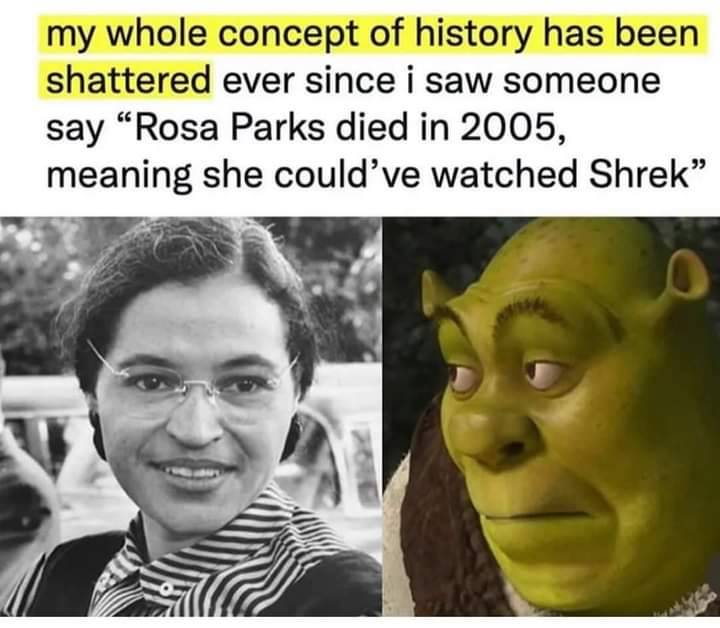this post was submitted on 05 Jul 2024
475 points (97.0% liked)
Funny
7446 readers
275 users here now
General rules:
- Be kind.
- All posts must make an attempt to be funny.
- Obey the general sh.itjust.works instance rules.
- No politics or political figures. There are plenty of other politics communities to choose from.
- Don't post anything grotesque or potentially illegal. Examples include pornography, gore, animal cruelty, inappropriate jokes involving kids, etc.
Exceptions may be made at the discretion of the mods.
founded 2 years ago
MODERATORS
you are viewing a single comment's thread
view the rest of the comments
view the rest of the comments

This is probably one of the most egregious reasons that civil rights photos are in black and white in the textbooks despite color cameras having been a well-established thing by then. To make it seem like it was long ago when it was/is still quite recent. RedliningYour textbooks are made in Texas and the publishers therefore use Texan standards nearly everywhere...Educational material should not be made in red states.
Textbooks are likely to use pictures from photojournalists which were mostly black and white in the days of print media. It also likely makes it cheaper to print the textbooks.
And yet other pictures of famous people in these textbooks were/are in color. There is a visual discrepancy in presentation and it misleads the viewer (children in this case) in a way they may not even realize for years or decades after. Whether this particular discrepancy is purposeful or not it is problematic.
celebrities get portraits done, civil rights leaders have pictures taken of them by journalists as they do important things. most civil rights leaders didn't get many professional portraits done, the textbooks use the pictures of them actually doing things. tough you may have a point that it would be good to include a color picture or two of them if they're out there.
There are color photos out there, ain't a hard thing to look up. Journalists were probably shooting in color even if they weren't getting printed that way since the average person could have a color camera by that point in time.
You're reading too much into it. Colour ink was still expensive back then up until the late '80s to '00s. Which is why coloured photos were uncommon before, especially in the 1960s.
And before anyone suggests it, professional historians strongly discourage colouring black and white photos. This could give false impression of what the actual colour of some objects, or the subject itself in the photo.
I just Googled by the way of your claim, it turns out that the narrative is indeed hamfisted: https://eu.usatoday.com/story/news/factcheck/2020/06/20/fact-check-most-civil-rights-era-images-werent-made-color/3210472001/
In addition to color being too expensive for textbooks, it was also too expensive for newspapers. And colour film was more expensive than black and white film. Since photos taken by photo journalists at the time were meant to be printed in newspapers in B&W, most photographers shot with B&W film even while the technology for colour photography existed.
Well... B&W does have better resolution, both back then and now. Notice how many photos from NASA probes are in B&W? It's because to get color you either have to take three photos with filters on them and combine them together, which is what NASA does. Or have clusters of three different sensors in an array to pick up the different wavelengths, which is what most consumer cameras do. But that effectively cuts the resolution into a third of what it could be if you had sensors that simply detected light without caring about the wavelength.
Of course the way most cameras are constructed you don't get any benefit from B&W in terms of resolution since the way the sensors are arrayed is optimized for colour. But NASA's cameras allow for higher resolution B&W images (when they already know the colour of the thing they're looking at and they want to see detail) and the filters are there when they need to figure out what colour something is.
Is that why photos of the USSR are mostly in black and white too?
Is it not good and effective that it's done that way?
Genuine conspiracy theory tier logic right up there with white people breaking noses off black statues.